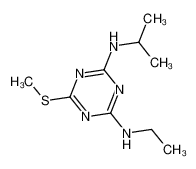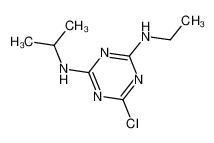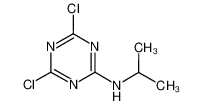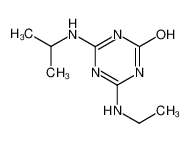| Product name | ametryn |
|---|
| Product number | - |
|---|---|
| Other names | Crisatrine |
| Identified uses | For industry use only. Herbicide |
|---|---|
| Uses advised against | no data available |
| Company | MOLBASE (Shanghai) Biotechnology Co., Ltd. |
|---|---|
| Address | Floor 4 & 5, Building 12, No. 1001 North Qinzhou Road, Xuhui District, Shanghai, China |
| Telephone | +86(21)64956998 |
| Fax | +86(21)54365166 |
| Emergency phone number | +86-400-6021-666 |
|---|---|
| Service hours | Monday to Friday, 9am-5pm (Standard time zone: UTC/GMT +8 hours). |
Acute toxicity - Oral, Category 4
Hazardous to the aquatic environment, short-term (Acute) - Category Acute 1
Hazardous to the aquatic environment, long-term (Chronic) - Category Chronic 1
2.2 GHS label elements, including precautionary statements| Pictogram(s) |   |
|---|---|
| Signal word | Warning |
| Hazard statement(s) | H302 Harmful if swallowed H410 Very toxic to aquatic life with long lasting effects |
| Precautionary statement(s) | |
| Prevention | P264 Wash ... thoroughly after handling. P270 Do not eat, drink or smoke when using this product. P273 Avoid release to the environment. |
| Response | P301+P312 IF SWALLOWED: Call a POISON CENTER/doctor/…if you feel unwell. P330 Rinse mouth. P391 Collect spillage. |
| Storage | none |
| Disposal | P501 Dispose of contents/container to ... |
none
3.Composition/information on ingredients 3.1 Substances| Chemical name | Common names and synonyms | CAS number | EC number | Concentration |
|---|---|---|---|---|
| ametryn | ametryn | 834-12-8 | none | 100% |
Consult a physician. Show this safety data sheet to the doctor in attendance.
If inhaledIf breathed in, move person into fresh air. If not breathing, give artificial respiration. Consult a physician.
In case of skin contactWash off with soap and plenty of water. Consult a physician.
In case of eye contactRinse thoroughly with plenty of water for at least 15 minutes and consult a physician.
If swallowedNever give anything by mouth to an unconscious person. Rinse mouth with water. Consult a physician.
4.2 Most important symptoms/effects, acute and delayedExcerpt from ERG Guide 151 [Substances - Toxic (Non-combustible)]: Highly toxic, may be fatal if inhaled, swallowed or absorbed through skin. Avoid any skin contact. Effects of contact or inhalation may be delayed. Fire may produce irritating, corrosive and/or toxic gases. Runoff from fire control or dilution water may be corrosive and/or toxic and cause pollution. (ERG, 2016)
4.3 Indication of immediate medical attention and special treatment needed, if necessarySkin decontamination. Skin contamination should be treated promptly by washing with soap and water. Contamination of the eyes should be treated immediately by prolonged flushing of the eyes with large amounts of clean water. If dermal or ocular irritation persists, medical attention should be obtained without delay. /Other herbicides/
5.Fire-fighting measures 5.1 Extinguishing media Suitable extinguishing mediaIf material on fire or involved in fire: Do not extinguish fire unless flow can be stopped or safely confined. Use water in flooding quantities as fog. Solid streams of water may be ineffective. Cool all affected containers with flooding quantities of water. Apply water from as far a distance as possible. Use "alcohol" foam, carbon dioxide or dry chemical. /Triazine pesticides, liquid, NOS/
5.2 Specific hazards arising from the chemicalExcerpt from ERG Guide 151 [Substances - Toxic (Non-combustible)]: Non-combustible, substance itself does not burn but may decompose upon heating to produce corrosive and/or toxic fumes. Containers may explode when heated. Runoff may pollute waterways. (ERG, 2016)
5.3 Special protective actions for fire-fightersWear self-contained breathing apparatus for firefighting if necessary.
6.Accidental release measures 6.1 Personal precautions, protective equipment and emergency proceduresUse personal protective equipment. Avoid dust formation. Avoid breathing vapours, mist or gas. Ensure adequate ventilation. Evacuate personnel to safe areas. Avoid breathing dust. For personal protection see section 8.
6.2 Environmental precautionsPrevent further leakage or spillage if safe to do so. Do not let product enter drains. Discharge into the environment must be avoided.
6.3 Methods and materials for containment and cleaning upFor minor spills, follow all precautions indicated on this label and clean up immediately. Take special care to avoid contamination of equipment and facilities during cleanup procedures and disposal of wastes. ... /Ametryn Technical/
7.Handling and storage 7.1 Precautions for safe handlingAvoid contact with skin and eyes. Avoid formation of dust and aerosols. Avoid exposure - obtain special instructions before use.Provide appropriate exhaust ventilation at places where dust is formed. For precautions see section 2.2.
7.2 Conditions for safe storage, including any incompatibilitiesStore in cool, dry place.
8.Exposure controls/personal protection 8.1 Control parameters Occupational Exposure limit valuesno data available
Biological limit valuesno data available
8.2 Appropriate engineering controlsHandle in accordance with good industrial hygiene and safety practice. Wash hands before breaks and at the end of workday.
8.3 Individual protection measures, such as personal protective equipment (PPE) Eye/face protectionSafety glasses with side-shields conforming to EN166. Use equipment for eye protection tested and approved under appropriate government standards such as NIOSH (US) or EN 166(EU).
Skin protectionWear impervious clothing. The type of protective equipment must be selected according to the concentration and amount of the dangerous substance at the specific workplace. Handle with gloves. Gloves must be inspected prior to use. Use proper glove removal technique(without touching glove's outer surface) to avoid skin contact with this product. Dispose of contaminated gloves after use in accordance with applicable laws and good laboratory practices. Wash and dry hands. The selected protective gloves have to satisfy the specifications of EU Directive 89/686/EEC and the standard EN 374 derived from it.
Respiratory protectionWear dust mask when handling large quantities.
Thermal hazardsno data available
9.Physical and chemical properties| Physical state | White Powder |
|---|---|
| Colour | White powder |
| Odour | no data available |
| Melting point/ freezing point | 84-85ºC |
| Boiling point or initial boiling point and boiling range | 396.4ºC at 760 mmHg |
| Flammability | no data available |
| Lower and upper explosion limit / flammability limit | no data available |
| Flash point | 193.5ºC |
| Auto-ignition temperature | no data available |
| Decomposition temperature | no data available |
| pH | no data available |
| Kinematic viscosity | no data available |
| Solubility | Readily soluble in organic solvents |
| Partition coefficient n-octanol/water (log value) | log Kow = 2.98 |
| Vapour pressure | 2.74X10-6 mm Hg at 25°C |
| Density and/or relative density | 1.15 g/cm3 |
| Relative vapour density | no data available |
| Particle characteristics | no data available |
no data available
10.2 Chemical stabilityVery stable over several yr of shelf life & only slight sensitivity to natural light & extreme temperatures.
10.3 Possibility of hazardous reactionsNonflammable.An amine, organosulfide. Organosulfides are incompatible with acids, diazo and azo compounds, halocarbons, isocyanates, aldehydes, alkali metals, nitrides, hydrides, and other strong reducing agents. Reactions with these materials generate heat and in many cases hydrogen gas. Many of these compounds may liberate hydrogen sulfide upon decomposition or reaction with an acid. Amines are chemical bases. They neutralize acids to form salts plus water. These acid-base reactions are exothermic. The amount of heat that is evolved per mole of amine in a neutralization is largely independent of the strength of the amine as a base. Amines may be incompatible with isocyanates, halogenated organics, peroxides, phenols (acidic), epoxides, anhydrides, and acid halides. Flammable gaseous hydrogen is generated by amines in combination with strong reducing agents, such as hydrides.
10.4 Conditions to avoidno data available
10.5 Incompatible materialsno data available
10.6 Hazardous decomposition productsWhen heated to decomposition it emits very toxic fumes of /nitrogen and sulfur oxides/.
11.Toxicological information Acute toxicity- Oral: LD50 Rat oral 1100 mg/kg /Technical/
- Inhalation: LC50 Rat (albino) inhalation >27 mg/L/4 hr
- Dermal: LD50 Rat percutaneous > 3100 mg/kg
no data available
Serious eye damage/irritationno data available
Respiratory or skin sensitizationno data available
Germ cell mutagenicityno data available
CarcinogenicityCancer Classification: Data are Inadequate for an Assessment of Human Carcinogenic Potential
Reproductive toxicityno data available
STOT-single exposureno data available
STOT-repeated exposureno data available
Aspiration hazardno data available
12.Ecological information 12.1 Toxicity- Toxicity to fish: LC50 Oncorhynchus mykiss (Rainbow trout, weight 0.5 g) 3.2 mg/L/96 hr at 13°C /Static bioassay
- Toxicity to daphnia and other aquatic invertebrates: no data available
- Toxicity to algae: no data available
- Toxicity to microorganisms: no data available
AEROBIC: Several soil bacteria and fungi are reported to attack ametryne(1). The methylthio group is known to undergo sulfoxidation by microsomal enzymes in plant and animal systems and the same reactions usually hold true for soil microorganisms(1). Methylthio-s-triazine herbicides are generally more resistant to biodegradation than the corresponding chloro-s-triazines(1). No biodegradation was observed when 200 ppm of ametryne was incubated for a month using a soil suspension inoculum at 30°C(2). When the concn equivalent of 3 kg/ha of ametryne was incubated in a clay-lime soil, 2.8% and 8.6% of the herbicide degraded to CO2 in 51 and 110 days, respectively(2). In another experiment, 10-50% degradation in 10 days occurred in one of four soils, while degradation was either absent or uncertain in the other three soils(3). In a 25-day experiment, CO2 evolution occurred from ametryne-treated sterile soil that had been inoculated with an extract from ametryne enriched soil, but not from uninoculated controls(1). After 60 days incubation, 8.7% and 63.7% of the applied ametryne remained in inoculated Hilo silty clay loam and Molakai silty clay, two Hawaiian soils that are typically used in the cultivation of sugarcane(4). The inoculum was prepared by leaching Molakai soil with ametryne solutions(4). Biodegradation initially involved N-dealkylation. Less than 0.2% of the ametryne degraded to CO2 in this period(4). No significant degradation occurred in autoclaved controls(4). Ametryne has been shown to be susceptible to degradation by Nocardiodes sp.(5).
12.3 Bioaccumulative potentialAn estimated BCF of 19 was calculated in fish for ametryne(SRC), using a log Kow of 2.98(1) and a regression-derived equation(2). According to a classification scheme(3), this BCF suggests the potential for bioconcentration in aquatic organisms is low(SRC).
12.4 Mobility in soilThe average Koc reported for ametryne in 32 soils was 388.4(1). Ametryne has a Koc value of 300(2). Mean overall Koc values measured in four Hawaiian soils were 257 for surface soil (0 to 20 cm) and 170 for subsoil (60 to 80 cm); Kocs of 530, 170, 156, and 171 were measured in the surface soil of Torrox (mean % OC 1.30, pH 6.7), Eustrustox (mean OC 1.63%, pH 6.4), Tropohumult (mean OC% 2.88, pH 5.3), and Hydrandept (mean OC% 6.22, pH 5.3); Kocs of 235, 254, 87, and 107 were measured in subsoil of Torrox (mean OC% 0.55, pH 6.8), Eustrustox (mean OC% 0.76, pH 5.7), Tropohumult (mean OC% 1.51, pH 5.3), and Hydrandept (mean OC% 3.19, pH 5.6)(3). Koc values were measured for two Kishon River sediments; Kfar Yehushua was 69.33 (7.1 pH, 30% sand, 30% silt 40% clay 1.63% TOC) and Haifa industrial area was 170.40 (6.8 pH, 30 % sand, 20% silt, 50% clay, 1.25% TOC)(4). Koc values ranged from 102-123 in fresh soils amended with activated sludge, anaerobic digested sludge and compost, and 69-129 in incubated soils with the same amendments(5). According to a classification scheme(6), these Koc values suggest that ametryne is expected to have moderate to high mobility in soil(SRC). Of 38 values sited in literature the mean Kd is 5.69(7).
12.5 Other adverse effectsno data available
13.Disposal considerations 13.1 Disposal methods ProductThe material can be disposed of by removal to a licensed chemical destruction plant or by controlled incineration with flue gas scrubbing. Do not contaminate water, foodstuffs, feed or seed by storage or disposal. Do not discharge to sewer systems.
Contaminated packagingContainers can be triply rinsed (or equivalent) and offered for recycling or reconditioning. Alternatively, the packaging can be punctured to make it unusable for other purposes and then be disposed of in a sanitary landfill. Controlled incineration with flue gas scrubbing is possible for combustible packaging materials.
14.Transport information 14.1 UN Number| ADR/RID: UN1230 | IMDG: UN1230 | IATA: UN1230 |
| ADR/RID: METHANOL |
| IMDG: METHANOL |
| IATA: METHANOL |
| ADR/RID: 3 | IMDG: 3 | IATA: 3 |
| ADR/RID: II | IMDG: II | IATA: II |
| ADR/RID: yes | IMDG: yes | IATA: yes |
no data available
14.7 Transport in bulk according to Annex II of MARPOL 73/78 and the IBC Codeno data available
15.Regulatory information 15.1 Safety, health and environmental regulations specific for the product in question| Chemical name | Common names and synonyms | CAS number | EC number |
|---|---|---|---|
| ametryn | ametryn | 834-12-8 | none |
| European Inventory of Existing Commercial Chemical Substances (EINECS) | Listed. | ||
| EC Inventory | Listed. | ||
| United States Toxic Substances Control Act (TSCA) Inventory | Not Listed. | ||
| China Catalog of Hazardous chemicals 2015 | Not Listed. | ||
| New Zealand Inventory of Chemicals (NZIoC) | Listed. | ||
| Philippines Inventory of Chemicals and Chemical Substances (PICCS) | Listed. | ||
| Vietnam National Chemical Inventory | Not Listed. | ||
| Chinese Chemical Inventory of Existing Chemical Substances (China IECSC) | Not Listed. | ||
| Creation Date | Aug 15, 2017 |
|---|---|
| Revision Date | Aug 15, 2017 |
- CAS: Chemical Abstracts Service
- ADR: European Agreement concerning the International Carriage of Dangerous Goods by Road
- RID: Regulation concerning the International Carriage of Dangerous Goods by Rail
- IMDG: International Maritime Dangerous Goods
- IATA: International Air Transportation Association
- TWA: Time Weighted Average
- STEL: Short term exposure limit
- LC50: Lethal Concentration 50%
- LD50: Lethal Dose 50%
- EC50: Effective Concentration 50%
- IPCS - The International Chemical Safety Cards (ICSC), website: http://www.ilo.org/dyn/icsc/showcard.home
- HSDB - Hazardous Substances Data Bank, website: https://toxnet.nlm.nih.gov/newtoxnet/hsdb.htm
- IARC - International Agency for Research on Cancer, website: http://www.iarc.fr/
- eChemPortal - The Global Portal to Information on Chemical Substances by OECD, website: http://www.echemportal.org/echemportal/index?pageID=0&request_locale=en
- CAMEO Chemicals, website: http://cameochemicals.noaa.gov/search/simple
- ChemIDplus, website: http://chem.sis.nlm.nih.gov/chemidplus/chemidlite.jsp
- ERG - Emergency Response Guidebook by U.S. Department of Transportation, website: http://www.phmsa.dot.gov/hazmat/library/erg
- Germany GESTIS-database on hazard substance, website: http://www.dguv.de/ifa/gestis/gestis-stoffdatenbank/index-2.jsp
- ECHA - European Chemicals Agency, website: https://echa.europa.eu/


























